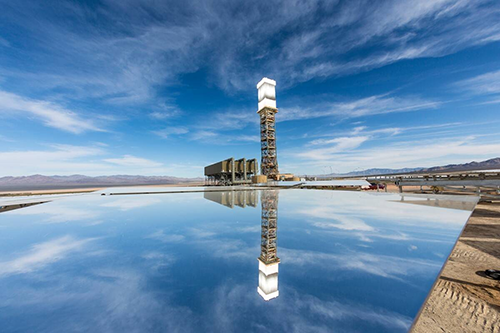Flying across the southwestern United States, the Mojave Desert wasteland in the distance shines with dazzling light. Three luminous points hover on the horizon, each surrounded by a glittering field. These are the towers and mirrors (heliostats) of Ivanpah Power Station, one of the largest concentrating solar power plants on the earth. What is this technology that allows solar energy to generate electricity continuously at night and how does it work?

Lvanpah Solar Power Station
Traditional photovoltaic (PV) solar cells absorb sunlight and discharge electricity. Light particles (photons) emitted by the sun travel through space, through the Earth’s atmosphere, and then hit solar panels. Some photons are reflected off the panel and lost. Most of them are absorbed by the atoms of the panel and then released electrons. The electrical design of the solar cell collects these electrons and exports them as current. Further electrical equipment converts this low voltage direct current (DC) to high voltage alternating current (AC) for transmission through transmission lines.
Concentrated solar thermal (CST) power plants do not directly exchange solar photons for electrons. They collect photons and use them to heat water, which drives the steam turbine, which in turn drives the generator. This is the same way nuclear fission and fossil fuel power plants generate electricity – except that uranium, coal or natural gas are replaced by the heat of the sun’s rays.

A heliostat that shines extremely bright at night
The basic design of the solar concentrator is simple. A series of heliostats are built on the ground. A heliostat is a term for a mirror on a rotating bracket that can track the sun. These arrays cover hundreds of acres, roughly comparable to large traditional solar power plants of similar capacity. Each mirror is constantly adjusted to point in a direction that bisects the angle between the sun and the huge power tower.
Close to the central tower, the sunlight gathered by thousands of mirrors becomes extremely bright, which can be seen from miles away. This intensity of sunlight finally drives power generation. The top of the tower is a white “transparent box”, which absorbs the sunlight gathered by the mirror.
The “light” that illuminates the night
Compared with traditional photovoltaic solar cell technology, solar thermal concentration provides a major advantage: schedulability. Properly configured CST plants can heat molten salt to more than 1000 degrees Fahrenheit, thereby storing a large amount of heat energy. The liquid salt is then pumped into a tank to act as a battery. When sunlight is not available (about half the time), this stored solar energy can be pumped out of the water tank and used to power the turbine generator for on-demand power supply at night.
At present, the installed power generation of CST in the world is relatively low. Although the technology has made relevant plans to promote it, the current cost is too high to compete with standard photovoltaic cells. Many countries, including Israel, the United Arab Emirates, Morocco, China, Chile, Spain and India, have built huge power tower installations.
Although the cost of centralized solar thermal power generation is getting lower and lower, the cost of photovoltaic cells is also dropping rapidly. The future of this energy is likely to depend on the continuous development of its energy storage capacity for dispatching power, which needs to fill in the inconsistent wind turbines and photovoltaic solar power plants.

Traditional photovoltaic cells
There are very limited options for storing energy today. Lithium ion technology has many shortcomings, which prevent countries from using battery power. Like batteries in laptops, they are expensive, degrade rapidly over time, and catch fire easily. The global production capacity is too small to complete this task. China, which holds half of the world’s lithium mines, dominates the lithium ion battery market, accounting for more than 60% of the world’s production capacity.
According to the U.S. National Blueprint for Lithium Battery 2020-2025 issued by the U.S. Energy Administration and formulated by the FCAB Federal Advanced Battery Alliance, this paper outlines the current position of the United States in the new energy industry, and how to improve the domestic plan to manufacture lithium ion batteries independently.
The report pointed out that the lithium battery industry seems to be at a critical point at present. Since 2010, the cost of lithium battery has dropped by nearly 90%, and it is affecting the global transportation market, and may reshape the global industry in the coming decades. It is estimated that by 2025, China’s lithium battery capacity will reach 1811GWh, accounting for 73% of the global share.
National Blueprint for 2020-2025 issued by the US Department of Energy
Thanks to our labor advantages, China can dominate many manufacturing industries. In addition, China’s lithium reserves and output far exceed that of the United States. In 2018, China’s lithium output was 8000 tons, ranking third among all countries and nearly 10 times that of the United States. In 2018, China’s lithium reserves were 1 million tons, almost 30 times that of the United States.
The future trend shows that lithium ion batteries will replace more lead-acid batteries in the field of transportation and heavy equipment. The shift to lithium batteries has brought many new challenges and opportunities, and China is holding another clean energy manufacturing opportunity in its hands.
Concentrated solar thermal (CST) power station
Focused solar thermal technology is simple and clean, and relevant design is still improving. Compared with solar energy, concentrating solar thermal technology can not only use photons to generate electricity in the daytime, but also effectively store sunlight at night for power dispatching at night. However, the concentrated solar thermal technology has a small share in the energy market due to its high cost, and only some innovative companies are following up.






